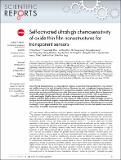Self-activated ultrahigh chemosensitivity of oxide thin film nanostructures for transparent sensors
Author(s)
Moon, Hi Gyu; Shim, Young-Soek; Kim, Do Hong; Jeong, Hu Young; Jeong, Myoungho; Jung, Joo Young; Han, Seung Min; Kim, Jong Kyu; Kim, Jin-Sang; Park, Hyung-Ho; Lee, Jong-Heun; Tuller, Harry L.; Yoon, Seok-Jin; Jang, Ho Won; ... Show more Show less
DownloadTuller_Self-activated.pdf (3.247Mb)
PUBLISHER_CC
Publisher with Creative Commons License
Creative Commons Attribution
Terms of use
Metadata
Show full item recordAbstract
One of the top design priorities for semiconductor chemical sensors is developing simple, low-cost, sensitive and reliable sensors to be built in handheld devices. However, the need to implement heating elements in sensor devices, and the resulting high power consumption, remains a major obstacle for the realization of miniaturized and integrated chemoresistive thin film sensors based on metal oxides. Here we demonstrate structurally simple but extremely efficient all oxide chemoresistive sensors with ~90% transmittance at visible wavelengths. Highly effective self-activation in anisotropically self-assembled nanocolumnar tungsten oxide thin films on glass substrate with indium-tin oxide electrodes enables ultrahigh response to nitrogen dioxide and volatile organic compounds with detection limits down to parts per trillion levels and power consumption less than 0.2 microwatts. Beyond the sensing performance, high transparency at visible wavelengths creates opportunities for their use in transparent electronic circuitry and optoelectronic devices with avenues for further functional convergence.
Date issued
2012-08Department
Massachusetts Institute of Technology. Department of Materials Science and EngineeringJournal
Scientific Reports
Publisher
Nature Publishing Group
Citation
Moon, Hi Gyu, Young-Soek Shim, Do Hong Kim, Hu Young Jeong, Myoungho Jeong, Joo Young Jung, Seung Min Han, et al. “Self-Activated Ultrahigh Chemosensitivity of Oxide Thin Film Nanostructures for Transparent Sensors.” Sci. Rep. 2 (August 17, 2012).
Version: Final published version
ISSN
2045-2322